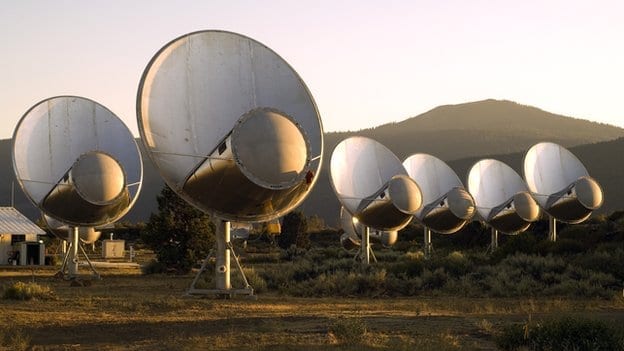
via BBC
Making our presence known might be dangerous
Researchers involved in the search for extra-terrestrial life are considering what the message from Earth should be.
The call has been made at the American Association for the Advancement of Science meeting in San Jose.
But others argued that making our presence known might be dangerous.
Researchers at Seti have been listening for signals from outer space for more than 30 years using radio telescope facilities in the US. So far there has been no sign of ET.
The organisation’s director, Dr Seth Shostak, told scientists at the AAAS meeting that it is now time to step up the search.
“Some of us at the institute are interested in ‘active Seti‘, not just listening but broadcasting something maybe to some nearby stars because maybe there is some chance that if you wake somebody up you’ll get a response,” he told BBC News.
The concerns are obvious, but sitting in his office at the institute in Mountain View, California, in the heart of Silicon Valley he expresses them with characteristic, impish glee.
Game over?
“A lot of people are against active Seti because it is dangerous. It is like shouting in the jungle. You don’t know what is out there, you better not do it. If you incite the aliens to obliterate the planet, you wouldn’t want that on your tombstone, right?”
I couldn’t argue with that. But initially, I could scarcely believe I was having this conversation at a serious research institute rather than a science fiction convention.
The Latest on: Active SETI
[google_news title=”” keyword=”Active SETI” num_posts=”10″ blurb_length=”0″ show_thumb=”left”]
via Google News
The Latest on: Active SETI
- SETI Scientist Says Announcement of Alien Life Could Be Imminenton April 25, 2024 at 12:37 pm
Webby Awards One of the world's foremost experts in the search for extraterrestrial intelligence (SETI) believes that with the help of the James Webb Space Telescope, humans are closer to discovering ...
- SETI Scientist Says Announcement of Alien Life Could Be Imminenton April 25, 2024 at 12:37 pm
One of the world's foremost experts in the search for extraterrestrial intelligence (SETI) believes that with the help of the James Webb Space Telescope, humans are closer to discovering life ...
- SETI chief says US has no evidence for alien technology. 'And we never have'on April 16, 2024 at 5:01 pm
But spoiler alert: For the chief leader of the SETI Institute, established to search for and understand life beyond Earth, there's a need to step back and cuddle up to a cup of cosmic reality.
- SETI Institute Claims They've Successfully Communicated With a Whaleon April 16, 2024 at 1:31 pm
A team of scientists from the SETI Institute, which is devoted to the Search for Extraterrestrial Intelligence, claims to have "conversed" with a humpback whale in Alaska. While it may sound a little ...
- SETIGO: A New Way of SETI and Gamification of Public Science, AI Avatar Supported by Openverseon March 21, 2024 at 12:00 am
Powered by next-generation gamification and social networking, SETIGO's innovative model fosters active participation ... in the fields of astronomy and SETI, as well as from prominent telescope ...
- Massive Martian active volcano taller than Evereston March 15, 2024 at 8:58 am
A giant, active volcano taller than Everest has been ... Lead author Dr. Pascal Lee, a planetary scientist with the SETI Institute and the Mars Institute, said: “We were examining the geology ...
- Giant Volcano On Mars Found Hiding In Plain Sight, Scientists Sayon March 13, 2024 at 12:32 pm
Planetary scientist Pascal Lee with the SETI Institute and the Mars Institute ... The volcano could still be active. The combination of volcanic heat and water ice makes this an intriguing place ...
- Late Qualcomm cofounder teleports $200M into SETI to bankroll hunt for alien lifeon November 9, 2023 at 12:27 pm
Diamond told us that Antonio was also an active member of SETI's technical team and was a regular attendee at weekly meetings. In addition to funding modernization work on the Allen Telescope ...
- Communications with Extraterrestrial Intelligenceon August 25, 2021 at 11:22 pm
Second, both proponents and opponents of “Active SETI” debate whether humankind should be transmitting intentional signals to other possible civilizations, rather than only listening. Third, ...
- Are Aliens Real? Is There Life on Other Planets?on August 15, 2020 at 5:45 pm
But as SETI Institute senior astronomer Seth Shostak ... An estimate of 100,000 (10 5) active civilizations in the galaxy would mean one per million star systems. At the exponential rate of ...
via Bing News










